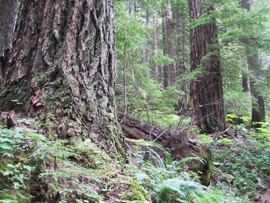
If you have recently purchased forest land, you may be challenged by the task of managing this resource. Forests represent a significant and complex component of our natural environment that constantly changes through natural and human made impacts.
Develop a Plan
A great first step for a woodland manager is to develop a stewardship plan. The best way to start is to walk your land and inventory what is there. Also begin to think about your objectives for your property. Eventually, you can complete a more formal inventory of the land and document it in your plan. You may wish to seek the help of a professional forester or the soil & water conservation district in developing your plan.
Some things to consider while developing a plan:
- The existing tree, shrub, and understory plant types
- Soil type and drainage
- Size and location of streams
- Tree health including insect or disease damage
- Existing wildlife habitat
- Wildfire risk
- Markets for lumber or other forest products
You may need to modify your goals and objectives to match your land’s natural capabilities.
Managing for Your Objectives
Healthy trees, quality fish and wildlife habitat, and forest products are just a few of the objectives that woodland owners have in mind.
Woodland Health
- Invasive weeds often take up valuable space where healthy, native trees should be growing. See the ‘Weeds’ section for more details on how to control invasive species.
- As trees grow, they may begin to crowd each other and their growth will slow down. This is a good time to remove a few trees to give the others more space.
- Insects and diseases can damage the health of your woodland, but professionals are available to help you devise a plan to manage these problems.
Fish & Wildlife Habitat
- Wooded streamsides improve water quality and cool water temperatures. They also add cover for animals that travel along stream corridors.
- Diverse forests with several different species can accommodate the needs of multiple species of wildlife.
- Dead trees, when they’re not located in a dangerous area, can be wonderful habitat for woodpeckers, flying squirrels, and several other species of wildlife.
Forest Products
- A healthy forest offers more opportunity for economic return on timber and other forest products.
- Planting appropriate species on the best soils will help you grow large trees faster.
- Attend woodland owner meetings and learn more about harvesting and marketing special forest products like mushrooms, floral greens, and other goods.
The Oregon Forest Practices Act
In Oregon, there are some regulations that govern how we manage our forests and the process is administered by the Oregon Department of Forestry. These regulations are meant to protect Oregon’s valuable forest resources including water quality and fish and wildlife habitat. Much of the management in your forest will require you to submit a notification to ODF at least 15 days before beginning. Activities that trigger the need for notification include:
- Harvesting or salvaging trees
- Site preparation and reforestation
- Chemical application
- Clearing forest land for non-forest uses
- Road construction and improvements
Forest practice rules require tree retention along many streams, wetlands, and lakes. Operators must protect soils, fish and wildlife habitat, and water quality. This website discusses the specific requirements.
http://www.oregon.gov/ODF/Working/Pages/HelpingLandowners.aspx
Sources of More Information
ODF’s Forestry Assistance Program offers technical advice and administers cost-share for completing various noncommercial forest and resource management activities. Visit the ODF Forestry Assistance Program site here.
Oregon State University (OSU) Forestry and Natural Resource Extension has useful fact sheets and online presentations. They offer many programs and training sessions, including the Master Woodland Manager program. Visit the OSU Forestry and Natural Resource extension site here.
Oregon Small Woodland Association is a useful membership group. Visit their site here.
